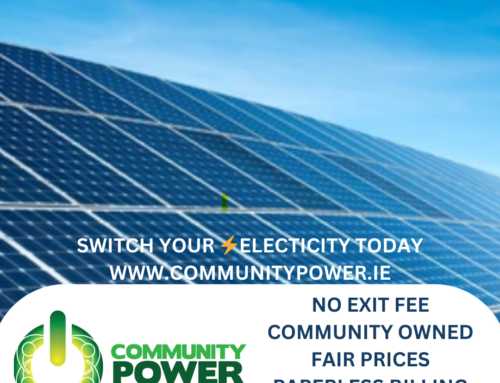
Community Power generates electricity exclusively from renewables. Prices of oil and gas have risen, and Community Power has been forced to increase electricity tariffs. But why does the price of oil and gas affect the electricity tariffs for Community Power customers?
The answer is that Community Power (and other electricity suppliers) actually play two roles – an electricity generation role and an electricity retail role. It is like a farmers market stall which sells some items the farmer has grown herself, and some items which the farmer has bought in from a food wholesaler. When you as a customer need electricity, Community Power uses the power generated by our community renewables as much as it can, but for the remainder of the electricity which is supplied to you, Community Power must buy it on the wholesale electricity market. Prices in the wholesale electricity market are largely driven by fossil fuel prices, because the electricity grid as a whole still heavily relies on fossil fuels.
What can be done about this?
– More community owned renewables: Community Power wants to connect more community owned renewable energy generation to the grid (and is awaiting connection agreements from the ESB, working through the many barriers which make this process difficult for small scale community renewables). More connections will help to lower customer tariffs, because Community Power can then provide customers with more of community renewable supply, which does not need expensive fossil fuels, and less electricity from the wholesale market. You can help by raising this issue with your political representatives, asking them to ensure that the ESB facilitates community renewable energy connection agreements.
– Energy efficiency: Be aware of the energy rating (watts) of different appliances in your home. If you have children, involve them in this as a treasure hunt for wattage labels around the house! The wattage of appliances is usually written on the appliance or in a user manual. You will notice that appliances which heat, cool or move things use the most energy. If you are replacing an appliance, consider the energy rating. Take advantage of government grants and financing schemes for home insulation and retrofits if you can. Don’t waste energy you don’t need.
– Rooftop solar: If you can, invest in rooftop solar PV panels (or solar thermal water heating panels) for your home. This will reduce your electricity usage, particularly during the summer months. For example, a 2 kW rooftop solar PV system can generate more than 9 kWh over the course of a May day, whereas a water heat pump system may use only 3 kWh on a May day, leaving plenty of electricity for other purposes. In the coming months, the Government is introducing feed-in tariffs for solar PV, so if you have a smart meter, Community Power can pay you for sending your excess solar electricity into the grid.
– Pay attention to timing: If you can time your electricity use to coincide with high wind and low overall demand, this will both reduce your carbon impact and also save Community Power money, which can then be passed to customers in the form of lower tariffs.
o How? Of course, some electricity you will need at particular times and you won’t be able to change that. However, there may be some electricity usage which you can alter the timing of. For example you may be able to run a washing machine, or time the immersion, or charge a car or ebike, at night time (when electricity demand from other households and from industry is low) or at times of high wind availability. This means that a higher proportion of your electricity will come from wind than if you used that electricity during a low-wind day-time.
o Switch to time-of-use tariffs – Community Power currently offers “standard smart tariff” to customers who have smart meters. The ESB is rolling out smart meters (free of charge) and you can follow up with them to ensure you get yours. If you get a smart meter installed, Community Power will know how much electricity you have used during the day and during the night, and charge you much lower rates for your night time usage, between 11pm and 8am, and a medium rate for non-peak usage, between 8am and 5pm and between 7pm and 11pm. This can help both your bills and also your carbon impact. See https://communityprw.wpengine.com/wp-content/uploads/2021/03/Codes-of-Practice-Smart-Metering.pdf for more information.
o Pay attention to the wind – if you use less electricity when it is calm, and instead use electricity when it is windy, this also lowers your carbon impact and helps save Community Power money in wholesale markets. You can see data on “carbon intensity of the grid” on the Eirgrid dashboard https://smartgriddashboard.com/#all/co2 – carbon intensity is low when there is a lot of wind, and this is the best time to use electricity. In the future, Community Power may introduce dynamic tariffs for customers that depend not only on the time of day but also on the carbon intensity (or wind) on the grid. This involves some upgrades to computer systems so Community Power is not capable of this yet. However, in the meantime, timing your electricity use with this in mind will still lower your carbon impact.
The importance of transparency
Community Power takes pride in being honest, open and transparent with customers. No electricity retailer in Ireland is retailing 100% renewable electricity, and unlike other renewable electricity retailers, Community Power don’t claim to be. Community Power also do not use “guarantees of origin” scheme on principle, as it is a flawed scheme which makes it seem that electricity is green in real time when it is not. Your invoice contains information on the actual source of the electricity Community Power sells to you, unlike other retailers who don’t provide this breakdown.
Thank you for your support
Community Power appreciates the support of customers during these difficult times. Community-owned renewables are an important part of building a better future for all of us.
Written by Elaine Baker 22/06/2022


